Duonamic Eleviia – A Portable Training Tool For The Travelling Climber.
The Duonamic Eleviia is a versatile portable pull-up bar system that mounts quickly to any door frame allowing climbers to squeeze in a workout without fear of damaging delicate drywall. We caught up with Taras Karpachevskyy and Jack Yang of Duonamic and discussed the challenges of prototyping a new product, the idiosyncrasies of microcontrollers and the advantages of the Eleviia over traditional pull-up bars and hangboards.
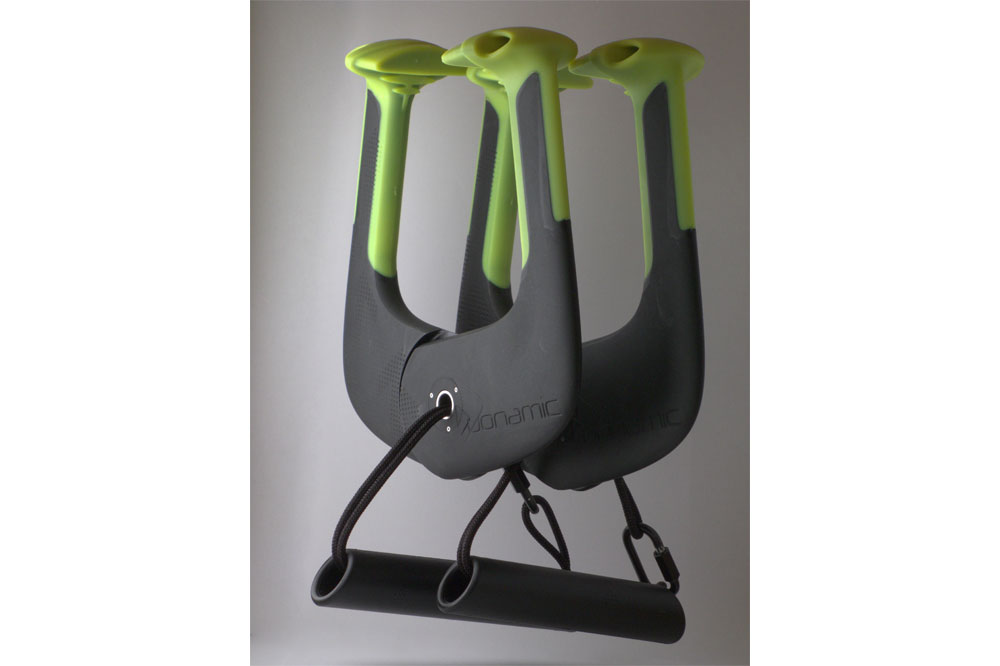
Duonamic Eleviia
Congratulations on starting Duonamic. Can you tell us what motivated you to start the company?
Taras: Jack and I were co-workers before we started Duonamic. Jack was travelling a lot for work and found that he couldn’t do pull-ups in many hotel gyms. He came up with the original idea for the Eleviia in a dream. I was pretty stoked about it because when I was little, my grandfather had installed a pull-up bar for me, and it was fantastic fun.
Who is involved with the company and what are your climbing and non-climbing backgrounds?
Jack: Duonamic consists of Taras and I. Taras is a mechanical engineer and an incredible hiker who blazes the walking trails around our office. He is responsible for the design, engineering and web development. I am also a mechanical engineer, and adrenaline junkie and adventure seeker. I enjoy multi-day hikes and flying down a mountain on a snowboard. I’m responsible for product development, marketing and sales. We also get amazing support from our families, friends and Instagram influencers!
There is a climbing gym near our work that a couple of co-workers frequent. We join them once in a while to test our grip strength and enjoy an adrenaline boost!
There is a climbing gym near our work that a couple of co-workers frequent. We join them once in a while to test our grip strength and enjoy an adrenaline boost!
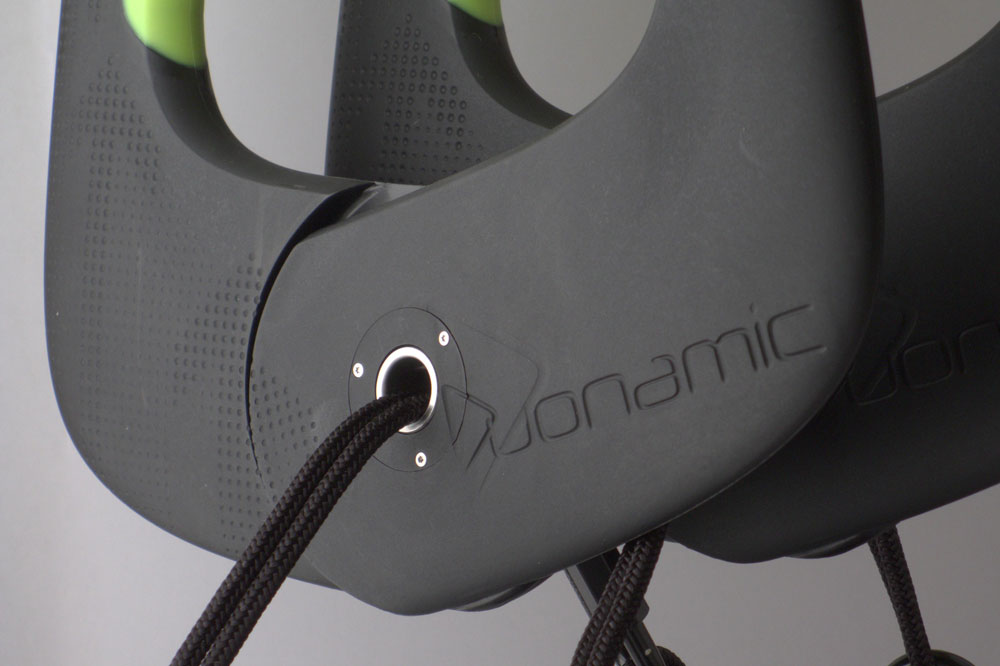
Duonamic Eleviia
You are currently selling the Eleviia. Can you describe this training tool?
Jack: The Eleviia is a portable doorway pull-up bar consisting of two door-clamps and suspended handles. There are couple of features that set the Eleviia apart from the rest of the pack. First, the handles are interchangeable This allows you to attach other holds for specific grip training. Second, the Eleviia is compact and lightweight so you can work out anywhere you have a door frame.
What are some of the advantages of the Eleviia compared to more traditional hangboards and pull-up bars?
Taras: Compared to traditional doorway pull-up bars, Eleviia won’t slip and doesn’t need to be mechanically attached to a door frame. A spring holds it closed around the door trim. There is nothing to screw in – just take it out of the bag, put it on the door (which takes 7.92 seconds) and go!
Jack: The hangboard is not really a competitor but a friendly training companion! Most hangboards can be suspended on a door using the Eleviia. This is useful if you want to avoid a more permanent installation.
Jack: The hangboard is not really a competitor but a friendly training companion! Most hangboards can be suspended on a door using the Eleviia. This is useful if you want to avoid a more permanent installation.
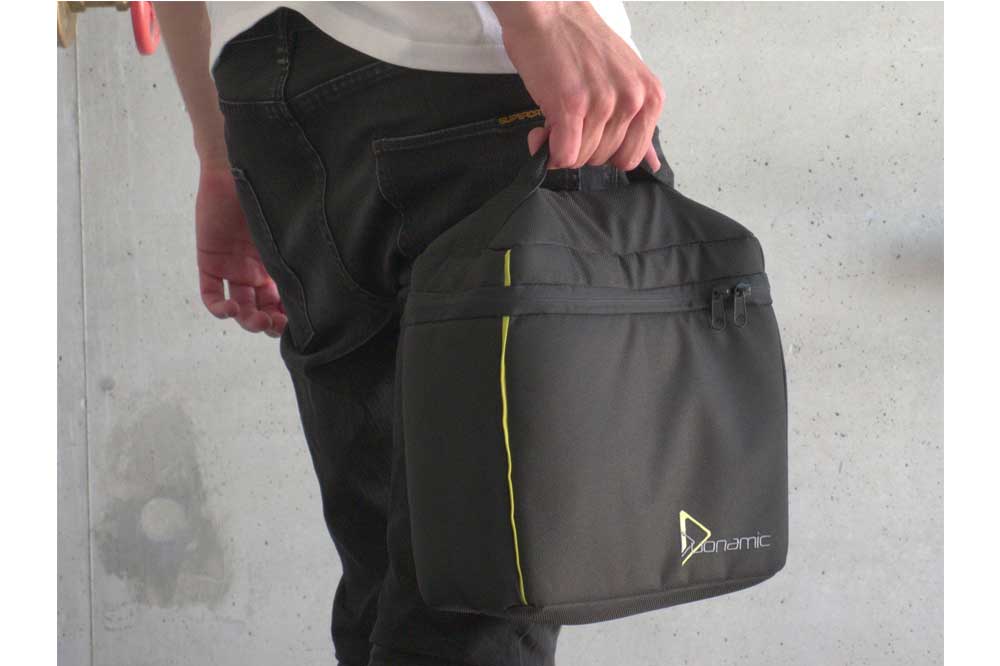
Duonamic Eleviia ready for travel.
Can you walk us through the development stages of the Eleviia? I assume there were plenty of prototypes!
Taras: Refining the original idea into a final product took a surprisingly long time.
Our first prototype was a quick-and-dirty aluminum and wood affair that clamped around the door like a pair of scissors. Its main purpose was for us to find out whether this type of attachment system could work.
The second major iteration was refining that scissor concept and trying to make it into something that could be mass produced. To safely support the load, we found that it needed a steel insert, which made it quite heavy. We also found that the scissor-like mechanism exerted a lot of force on the drywall – enough to dent it.
Then we had the idea to put the rope directly through the shaft. This change made the arms experience less stress for the same load. This meant we meant we could do away with the steel insert and shed some weight. It also reduced the force exerted on the drywall, so it was no longer being dented. Finally, this change also made it possible to add an internal spring so the arms would close.
In the last prototype, we increased the strength of the spring, added the green soft elastomer on the jaws to further protect wall surfaces and special rings to make the articulation of the arms smooth and precise.
Our first prototype was a quick-and-dirty aluminum and wood affair that clamped around the door like a pair of scissors. Its main purpose was for us to find out whether this type of attachment system could work.
The second major iteration was refining that scissor concept and trying to make it into something that could be mass produced. To safely support the load, we found that it needed a steel insert, which made it quite heavy. We also found that the scissor-like mechanism exerted a lot of force on the drywall – enough to dent it.
Then we had the idea to put the rope directly through the shaft. This change made the arms experience less stress for the same load. This meant we meant we could do away with the steel insert and shed some weight. It also reduced the force exerted on the drywall, so it was no longer being dented. Finally, this change also made it possible to add an internal spring so the arms would close.
In the last prototype, we increased the strength of the spring, added the green soft elastomer on the jaws to further protect wall surfaces and special rings to make the articulation of the arms smooth and precise.
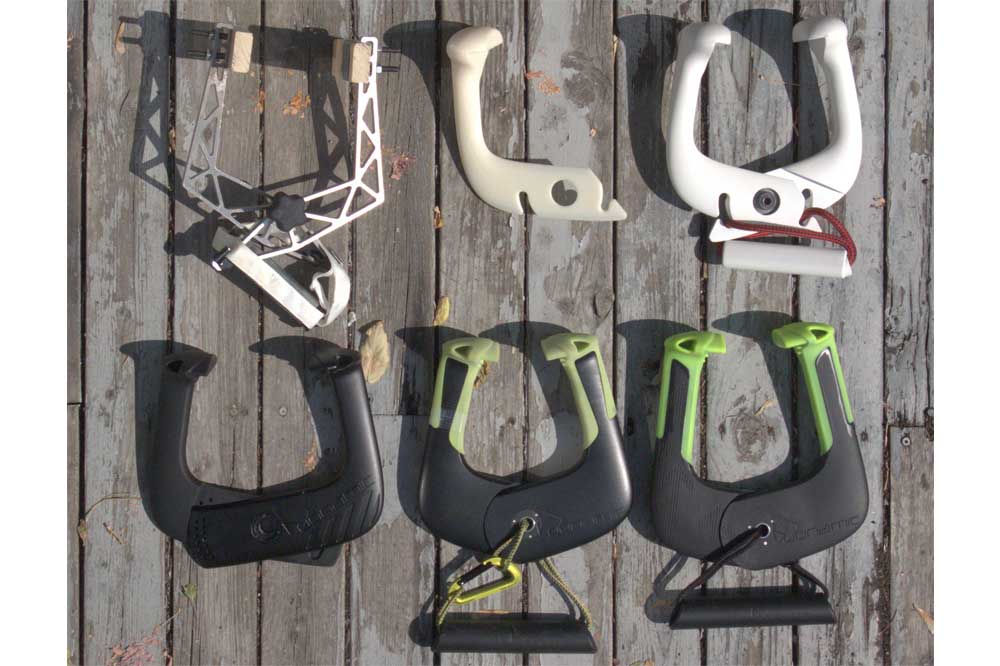
Duonamic Eleviia Prototypes
What were some of the more memorable challenges you faced trying to get the Eleviia to market?
Taras: There were too many to count, of course, but one of my favourites happened while building our fatigue tester. To ensure that the Eleviia would stand up to repeated loading and unloading during, we constructed a machine to cycle an Eleviia clamp thousands of times. It had an electric motor and a microcontroller that told the motor what to do. At first, I was having a surprisingly hard time programming the microcontroller – the motor was stopping at random times and making very strange noises. In the gentle words of a friend, it was “inconsistent with the intended behaviour of the program.” A later that evening, I discovered that a pair of high-current wires were too close to the microcontroller. The radio waves emitted by the wires were messing with the chip’s operation. Simply moving those wires farther away made everything behave the way it should.
Jack: Managing suppliers in Asia proved to be a bit more difficult than I imagined. We had to contend with different time zones, differences in technical terminologies and communication methods as well as cultural differences. We suffered a bit of a delay with the launch date, but in the end, we were satisfied with the quality of all the components.
Jack: Managing suppliers in Asia proved to be a bit more difficult than I imagined. We had to contend with different time zones, differences in technical terminologies and communication methods as well as cultural differences. We suffered a bit of a delay with the launch date, but in the end, we were satisfied with the quality of all the components.

Taras Karpachevskyy and Jack Yang of Duonamic.
And how about some of the more positive experiences?
Taras: We were making design changes throughout the whole design process, including after the last prototype. The final changes were small enough that we decided to take a risk and produce the expensive injection moulds without going through another prototype cycle (which would have delayed the launch by at least a month). We knew that all the parts should fit together in theory. It was quite a relief when we assembled the first one, and it came together perfectly.
Who do you see as the ideal customer for the Eleviia?
Jack: Anyone who wants to have portable exercise equipment. MJ, a climber at https://www.instagram.com/28000pullups/, is trying to complete 28000 pull-ups in a year and the Eleviia gives her the option to do pull-ups at home, at work, or when travelling to ensure she hits her goals every day.
Taras: People who want to do pull-ups or other hanging exercises, but don’t have space for a home gym. The easy set up makes a big difference. You don’t have to go out of your way to exercise. It’s right there, seconds away.
Taras: People who want to do pull-ups or other hanging exercises, but don’t have space for a home gym. The easy set up makes a big difference. You don’t have to go out of your way to exercise. It’s right there, seconds away.
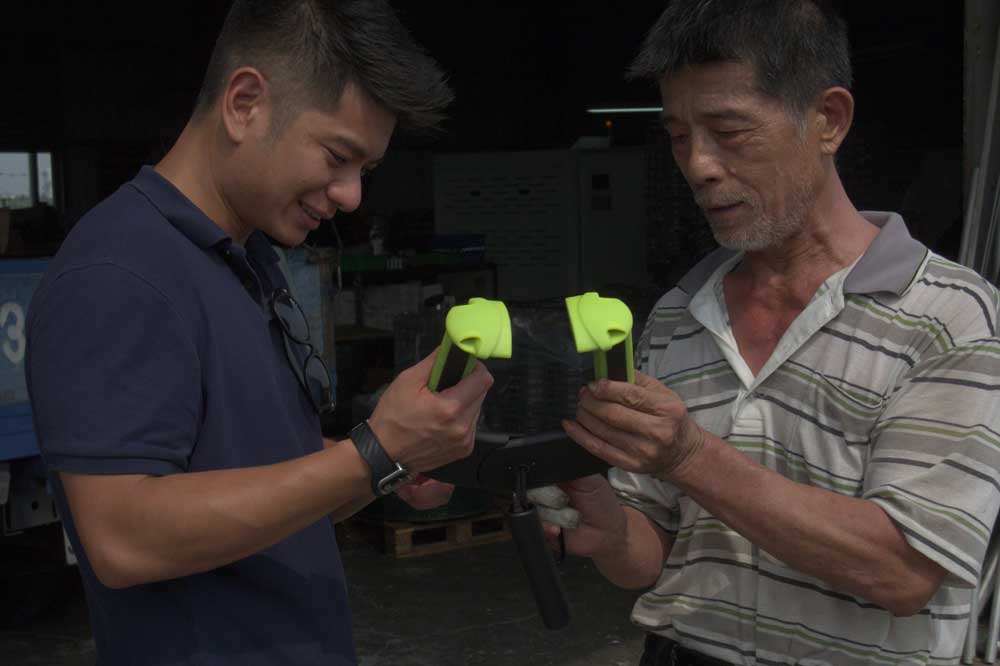
Examining The Duonamic Eleviia Components
Where is the company based and where is the Eleviia being produced?
Taras: We’re in Calgary, Canada. Most of the parts are made in Jack’s hometown – Tainan, Taiwan. We assemble them ourselves in Calgary, at least for now.
Where can folks purchase the Eleviia?
Jack: The Eleviia is available online at duonamic.com or in person at Fitters First (Calgary), and South Paw Gym (Calgary).
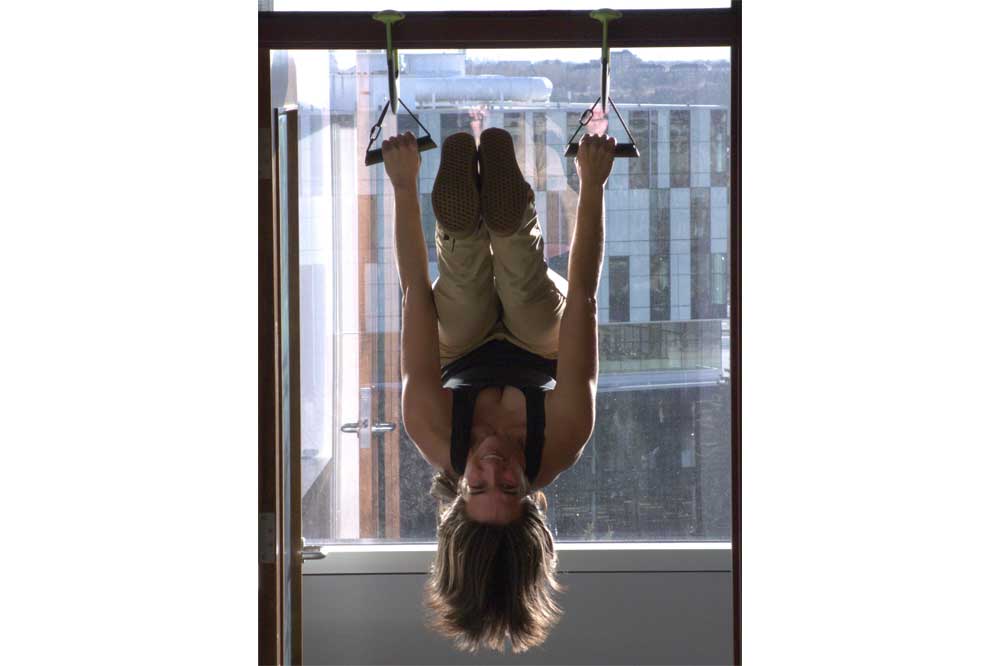
Using the Duonamic Eleviia.
Finally, any upcoming climbing trips?
Jack: Only trips to the Bolder Climbing Community in Calgary.


